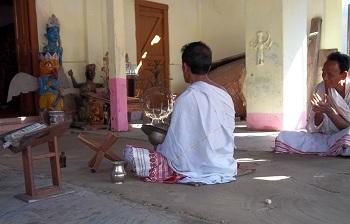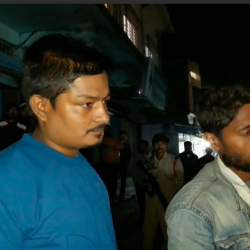An entrepreneur, generally, does not tread paths traveled by others. He is, by and large, not happy with the existing disposition and so he sets out to chart out his own road map. He creates challenges for himself and then sets his own standards. He never accepts defeat and takes all set backs on his stride. He always remains magnanimous and never allows himself to be bogged down by trivialities. Even against all odds, he remains steadfast as rock in his own convictions.
He is an entrepreneur in real sense of the term who does not work for himself. The fruits of his efforts are the resources for his society. The value system is also of his own to be followed by millions of others enrich their lives.
A successful entrepreneur leaves behind a legacy. He creates followers who carry forward that legacy; because he is a leader and he is accepted as a leader and that is the aura about him. People feel for him as he feels for them. They cry for him as he suffers for them. He makes life bigger and fuller for himself as well as for others. He creates avenues for others to grow and flourish. He not only creates wealth but basically builds up an institution or a number of them. So an entrepreneur is a social leader.
- He has to have personal charisma
- He has to maintain and increase his follower base.
- He has to keep them in good and positive spirit.
- He has to decentralize authority and responsibility amongst his followers.
- He has to be successful and also create successful models to inspire his followers.
- He has to be clear and appear to be clear in his perceptions and convictions and decisions and deeds.
- He has to be creative and he must prove that he is different and yet one among them.
- He must be expressive in more than one ways.
- He must show initiative in more than one area
- He must be talented in more than one trait
- AND finally He must be a caring human being with love, affection, transparency, credibility, ethos, dignity and humility.
In Xangkardev, the great social reformer, religious Saint, cultural icon, creative genius and social entrepreneur, we have all these intrinsic qualities blooming in luxuriant abundance. For a man to be born in the 15th century in a superstitious society ridden with casteism, black magic, idol worship , illiteracy and having no literature & philosophy & cultural practice worth the name and still be able to transform the whole lot of people into a nation of definite identity, it speaks volumes about this giant of a person. It seems virtually impossible to draw a parallel with any other person in world history having such creative genius barring a few of the likes of Leonardo de Vinci.
And what a rewarding studies to discover, one after another, the similes in virtues of a modern day entrepreneur in his personality, deeds and creations.
We may set out to unravel one by one.
A true entrepreneur has the unique capability to know and understand man. Xankardev had wonderful command over this domain. The first meeting and the subsequent initiation of Madhavdev into his hall of disciples (termed as Mani Kaanchan Xangjoog = confluence of ethereal Gold and Silver) considered to be the most auspicious moment in Assam’s socio-cultural history, precisely, for this reason.
In Madhavdev , the saint Xankardev saw the reflection of his image and the qualities necessary to imbibe, assimilate and propagate his teachings and values. The days and years that followed saw an explosion of creative brilliance in both of them and Assam started bathing in the basking glory of unstoppable literature, dance, music, songs et al.
Being a person of correct democratic values, his wisdom led him to decide upon Madhavdev as his successor much to the surprise of his sons and disciples.
Xangkardev created the seeds of Assam’s own Socio-Religious-Cultural institution called the Xattra. It was a set up which was headed by a Xatraadhikaar and which had a following in the form of disciples called Bhakats. It was a formalized institution which had a definite place of physical existence. It was run in a methodical , democratic and decentralized way with a laid down hierarchy .
The Xattraadhikaar is the head of a Xatra. The Dekaa- Xattraadhikaar was the incumbent in waiting. The Medhis were the disciple relation officers . The Muktiyaar was the registrar – responsible for the accounts and promulgator of strictures. On the other hand, the Aaldharaa was the personal assistant to Xatraadhikaar, Paachanee was the messenger, Khaataniyaar was the liaison officer between the king and a Xattraadhikaar, Haateemataa was the caller. The Naamghareeyaa was the caretaker of the Naamghar, Paaldharaa was the shift duty officer, Paathak was the reader in meetings, the Bhaagawatee was the reader of Bhaagawats, Gaayan – Baayan were the singer- musician band , the Sutradhar was the trainer of performing arts, the Bharaalee was the caretaker of Xattra stocks, the Deuree was the distributor, Khanikar was the architect- designer- planner etc.
Like the Ahom kings’ structure of governance ( Borgohain, Buragohain, Barpatragohain, Phukan, Hazarika, Saikia etc) a Xatras also has a functional hierarchy with defined duties and responsibilities. He created avenues for all of them to grow and flourish. He not only created social and cultural wealth but this unique institution of Xattra infused a lot of indelible values in Assam’s life.
The Xattras did take social leadership in many subsequent historical events like the freedom struggle against the British (As may be seen in the powerful novel Mrityunjay by the Gyanpeet awaedee Birendra Kr Bhattacharyya ).
The Xattras owned land and the Bhakats offered their labour to produce crops which was partly kept by the Xattra and partly given to those who had toiled. Regular religious discourses were held where knowledgeable people rendered explanations on religion and philosophy and moral values and ethics. It was a place of worship. It was a gravitating point for the Bhakats as well as for the society in the sense that for almost every conceivable matter, opinion of the Xattra was sought for, be it naming a new born child in a family or be it what profession should a son take or be it where a daughter was to be married off or be it settling a dispute. The Xattras had such tremendous control and hold on the disciples that its stricture was not easily defied.
The Xattra had a definite revenue collection system in place. The disciples paid an annual subscription. Those who could not pay in money terms were required to pay in kinds- may be some produce or some physical labour.
The Xattras were the places where, besides religion, regular practice of drama(Bhaaonaa), Music and Dance ( Bargeet and Xattreeya Dance ) were held. It is quite astonishing that without any patronage from the power that be and without much of written rules, the Xattras could preserve these beautiful Art forms in all their glory and purity for more than 500 years now.
It speaks volumes of the inner strength of the Xatras because of which the Xattreeyaa dance today is recognized as one of the classical dance forms of India. The core strength of the Xattras is amply demonstrated by this single fact.
The Xatras had a unique type of banking system. It used to receive extra agri produce of the Bhakats , store it and then lend it to those who needed it . It was to be replaced subsequently by the person and if he could not then he was required to compensate by other means such as serving the Xattra for a specified period as directed.
Xangkardev undertook two very long and arduous journeys on foot all alone traveling to places of religious importance like Kaashee, Brindaavan, Mathuraa, Xankar peeth, Puri etc. Just think of such a journey spanning 12 years together in the early sixteenth century India when there were no roads, no maps and no guides. These were the journeys of pure motivation and challenge.
Xangkardev was keen to study, learn and have a first hand feel of religion and philosophy. He wanted to bring its vast ocean to the illiterate, poor and backward people of Assam in an effort to change the society. He wanted to use religion as a tool for social change.
So he plunged into a barrage of literary creative endeavors in a language simple enough to be understood by the common man churning out such classics as the Keertan, The Bhaagawat, The Daxam Scandha, the Uttaraakaanda Raamaayan,the Anaadipaatan , the Bhakti Ratnaakar and the dramas like the Rukminee Haran , Raam Bijoy, Paarijaat Haran , Keligoopaal, Kaaleeya Daman etc.
The goal was clear in his mind- to churn out Amrit ( Honey for immortality ) from all that he could lay his hands upon (the scriptures of the great Indian civilization) and present it to the uneducated, poor, down trodden, socially ostracized masses - hopelessly resigned to fate.
His concern and care for the common man were so strong that he virtually created a whole new language for Assam and the Assamese by simplifying the difficult Sanskrit words ( e.g. Harsh- Harix, Manushya- Manich etc.).
In those times, talking against a religion or trying to change anything of a religion was considered blasphemous. But Xangkardev being a genius to the core did make a substantial change while bringing Krishna to Assam. Raadhaa and Krishna are inseparable characters in Indian psyche.
But Xangkardev thought that a tribal oriented society may not accept Raadhaa , who is elder to Krishna and is somebody else’s wife , mixing up in musical and dance escapades with all the symptoms of a damsel in love longing for union with her lover. Xangkardev did it and did it brilliantly and most effectively. Here nobody feels the absence of Raadhaa. What a stupendous literary achievement!
His innovations were so great that with effortless ease, he eliminated the distance between the performer and the audience. He tore down the concept of Proscenium style of theatrical presentation and created the Bhaawnaa where the audience sit surrounding the performance area from where they can touch the feet of ‘God’ as well as heartily enjoy the destruction of the ‘Demons’ .Earlier all performances were by the priestly people and in a language not understood by the masses. But now the common people, for the first time could enjoy something in a participative way. May be this was the first step towards empowerment of the people if we look at this in the back drop of those times.
As a true entrepreneur, whenever he felt something to be necessary but non existent, immediately he embarked upon a solution and was never overawed by a situation. One of the finest examples of this is his painting of the background screens or ‘PATS’ for his dramas with natural colours like Hengul- Haaitaal etc. If we go by chronology, then it may not be improper to suggest that centuries ahead of William Shakespeare, Xankardev created the first drama of the medieval world. It was named Chihna Jaatraa.
One of the greatest characteristics of this genius was the scale in which he operated. He always thought big and did big. The classic example of such a creation is the Brindaavanee Bastra , 180 feet long -depicting in woven design -stories from the Indian mythology- from the birth of Krishna to the destruction of the demon king ,Kangxa. These were stories or pictures in sequence- as if in motion – told visually, colorfully, artistically, methodically and that commanding respect. Was it a fore runner of modern day movies? – One may wonder no doubt.
It is awesome to even think that anything and everything that we talk of as a symbol of Assamese culture and identity are all his creations- Literature- poetry, drama, songs – Bargeet, the Bhaawnaa, the Mukhaa ( Mask ) ,the Xattra institution, Musical instruments- Khool, Mridanga, religion, prayer, the Naamghar ( it can not be simply translated as a prayer hall or temple), the Guru- Xishya ( tradition) parampara, Art – sculpture, painting, a dress code et al. Everything that he created had his own stamp of quality and standard because there was no earlier reference.
He was such a towering personality and he radiated so much wisdom that although he was virtually persecuted by the then power that be, yet he was well protected by the common people and he was accepted in the Royal court of the Kooch Behaar king Naranarayana and was bestowed with the highest royal honour. Although there was quite some danger to his life and security always, yet his charisma won over everybody.
His life was a mission to elevate ‘life’ from trivialities and he was abundantly successful in that. His was a life dedicated for others and this left behind a legacy of unparalleled reverence.
He was a leader who was accepted in totality because he was a person who embraced everybody irrespective of their faith, caste, ethnicity and viewpoint. This is a hall mark of a true leader. He practiced true detachment in attachment. He was a family man, yet his magnanimity encompassed the whole society.
The emergence of Xangkardev was a historical necessity. He took a different course in life and along with him the people and history of Assam took a different course. He charted his own road map and the destiny of all subsequent generations changed. Although persecuted, although he had to leave his place of origin, Bardoowaa, although he had lost his wife, yet nothing could extinguish his zeal. He was rock steady in pursuit of his creations and reformatory tendency within his own value system. He could derive a satisfaction that lives of thousands and lakhs of his direct and indirect followers and admirers changed for the better.
Like his literary creations all his other creations are richly successful in the context in which these were created. His success in opening up the minds of the people created waves of changes in the society and hundreds of Xattras sprang up after his death. These became epicenters of social life everywhere.
He was different, yet he was one of them. He was a superb communicator .He expressed himself in more than one ways. He took initiative in more than one area. And because he was understood very well he could survive till today and he is still growing in more ways than one. This is also a statement that he remains contemporary even today because of his universality.
To top it all, the saint was a great soul- loved and liked by all. Although deeply anchored in the common man yet he transcended all boundaries and became everybody’s man - an icon - a leader per excellence - a true social entrepreneur.
___
* Photo from sankaradeva.com
- 8627 reads









Add new comment